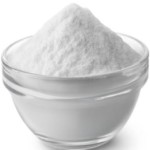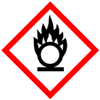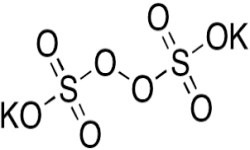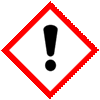CAS Number 7727-21-1, Potassium Persulfate or Potassium Persulphate Analytical Reagent Grade Manufacturers Exporters







CAS Number 7727-21-1, Potassium Persulfate or Potassium Persulphate Manufacturer Exporter
For Properties Specifications of Potassium Persulfate or Potassium Persulphate Click Properties, Specifications of Potassium Persulfate or Potassium Persulphate Manufacturer.
For Uses of Potassium Persulfate or Potassium Persulphate Click Uses of Potassium Persulfate or Potassium Persulphate Manufacturer.
For For SDS MSDS Sheet of Potassium Persulfate or Potassium Persulphate Click SDS Safety Data Sheet MSDS Sheet of Potassium Persulfate or Potassium Persulphate Manufacturer.
The Properties and Specifications of Potassium Persulfate or Potassium Persulphate:
Specifications of Potassium Persulfate or Potassium peroxydisulfate or KPS:
Appearance: white, crystalline.
Assay active oxygen content: min. 98.5 minimum
Chloride and chlorate(as Cl): 0.005% w/w maximum
Manganese (Mn): 0.0003% w/w maximum
Iron(Fe): 0.004% w/w maximum
Heavy metals (as Pb): 0.002% w/w maximum
Moisture: 0.15% w/w maximum.
Potassium Peroxydisulfate Analytical Reagent Grade Specifications
Potassium Persulfate
K2S2O8, Formula Weight 270.32
CAS Number 7727-21-1
REQUIREMENTS
Assay: 99.0% K2S2O8 minimum
MAXIMUM ALLOWABLE
Insoluble matter: 0.005%
Chlorine compounds (as Cl): 0.001%
Nitrogen compounds (as N): 0.001%
Heavy metals (as Pb): 0.001%
Iron (Fe): 5 ppm
Manganese (Mn): 2 ppm.
The Uses of Potassium Persulfate or Potassium Persulphate:
Potassium Persulfate is used in the production of soap and dyes, in photography, and as a medication. Potassium persulfate is used as bleach activator and desizing agent. It is used for the oxidative degradation of toxic substances. Potassium persulfate is used as free-radical initiator for polymerization. Potassium Persulphate used for bleaching and textile desizing, as an oxidizing agent and antiseptic,
The MSDS-SDS Hazard Statement of Potassium Persulfate or Potassium Persulphate:
Potassium Persulfate SDS, Safety Data Sheet
MSDS Sheet, Material Safety Data Sheet 17-Jan-23
1. Product & Company Identification
Product Name & Other Names: Potassium persulfate or Potassium peroxodisulfate.
CAS No.: 7727-21-1
EINECS EC Number: EC 231-781-8
Molecular Weight: 270.32
Chemical Formula: K2S2O8
Relevant uses and uses advised against (if any): Oxidizer for Oil & Gas Wells and Industrial Use.
2. Hazards Identification
GHS, Globally Harmonized System Classification in accordance with 29 CFR 1910
Classification according to Regulation (EC) No 1272/2008
Oxidizing Solids Category 3, H272
Acute toxicity - Oral Category 4, H302
Skin corrosion/irritation Category 2, H315
Serious eye damage/eye irritation Category 2A, H319
Respiratory sensitization Category 1, H334
Skin sensitization Category 1, H317
Specific target organ toxicity (single exposure) Category 3, H335
Acute aquatic toxicity Category 3, H402
Labeling according to GHS & Regulation (EC) No 1272/2008
GHS Label Elements  Oxidizing Solid |
GHS Label Elements |
GHS Label Elements |
Signal Word: Danger
Hazard Statements:
H272 - May intensify fire; oxidizer
H302 - Harmful if swallowed
H315 - Causes skin irritation
H317 - May cause an allergic skin reaction
H319 - Causes serious eye irritation
H334 - May cause allergy or asthma symptoms or breathing difficulties if inhaled
H335 - May cause respiratory irritation
H402 - Harmful to aquatic life.
Precautionary Statements - Prevention
P210: Keep away from heat/sparks/open flames/hot surfaces. - No smoking.
P220: Keep/Store away from clothing/combustible materials
P221: Take any precaution to avoid mixing with combustibles
P261: Avoid breathing dust.
P270: Do not eat, drink or smoke when using this product
P271: Use only outdoors or in a well-ventilated area
P272: Contaminated work clothing should not be allowed out of the workplace.
P280: Wear protective gloves/ protective clothing/ eye protection/ face protection
Precautionary Statements - Response
P301+P312: IF SWALLOWED: Call a POISON CENTER or doctor if you feel unwell.
P302+P352: IF ON SKIN: Wash with plenty of water.
P304+P341: IF INHALED: If breathing is difficult, remove to fresh air and keep at rest in a position comfortable for breathing.
P305+P351+P338: IF IN EYES: Rinse cautiously with water for several minutes. Remove contact lenses, if present and easy to do. Continue rinsing.
P314: Get Medical advice/attention if you feel unwell.
P333+P313: If skin irritation or rash occurs: Get medical advice/ attention.
P337+P313: If eye irritation persists: Get medical advice/ attention
P362: Take off contaminated clothing and wash before reuse.
P370+P378: In case of fire: Use water for extinction
Precautionary Statements - Storage
P402: Store in a dry place.
P403+P233: Store in a well-ventilated place. Keep container tightly closed
3. Composition/Information on Ingredients
Product Name & Other Names: Potassium persulfate or Potassium peroxodisulfate.
CAS No.: 7727-21-1
EINECS EC Number: EC 231-781-8
4. First Aid Measures
Always seek medical attention after first aid measures are provided.
Inhalation: Remove to fresh air. If not breathing, give artificial respiration. If breathing is difficult, give oxygen. Get medical attention.
Ingestion: If swallowed, do not induce vomiting. Give large quantities of water. Never give anything by mouth to an unconscious person. Get medical attention immediately.
Skin Contact: In case of contact, immediately flush skin with plenty of water for at least 15 minutes while removing contaminated clothing and shoes. Cover the irritated skin with an emollient. Cold water may be used. Wash clothing & shoes before reuse. Get medical attention.
Eye Contact: Check for and remove any contact lenses. In case of contact, immediately flush eyes with plenty of water for at least 15 minutes. Cold water may be used. Get medical attention.
5. Fire Fighting Measures
Fire: Not combustible, but substance is a strong oxidizer and its heat of reaction with reducing agents or combustibles may cause ignition. Heating or contact with water releases oxygen which may intensify combustion in an existing fire.
Explosion: An explosion hazard when mixed with finely powdered organic matter, metal powder, or reducing agents.
Special hazards arising from the substance or mixture: Sulphur oxides, Potassium oxides
Fire Extinguishing Media: Use water spray, alcohol-resistant foam, dry chemical or carbon dioxide. Use means suitable for extinguishing surrounding fire. Cool containers with flooding quantities of water until well after fire is out.
Special Information: In the event of a fire, wear full protective clothing and NIOSH-approved self-contained breathing apparatus with full face piece operated in the pressure demand or other positive pressure mode. At high temperatures under fire conditions, it may produce toxic or irritating fumes. Fire-extinguishing work is done from the windward and the suitable fire-extinguishing method according to the surrounding situation is used.
6. Accidental Release Measures
Personal precautions, protective equipment and emergency procedures: Avoid breathing dust/fumes/gas/mist/vapors/spray. Use individual protective equipment (waterproof boots, suitable protective clothing, safety glasses, etc.). Do not approach facing the wind.
Environmental precautions: Do not let the product enter drains, soil or water sources.
Methods and materials used for containment Cleanup procedures and Storage: It is an oxidizing material. Stop leak if without risk. Avoid contact with a combustible material (wood, paper, oil, clothing etc.). Keep the substance damp using water spray. Do not touch spilled material. Prevent entry into sewers. Contain spilled material. Eliminate all ignition sources. Vacuum or sweep-up and remove to an approved disposal container. Avoid penetration into waterways, sewers, soil or groundwater. Local authorities should be advised if significant spillages cannot be contained.
7. Handling and Storage
Precautions for safe handling: Apply according to good manufacturing and industrial hygiene practices. Ensure proper ventilation. Wash thoroughly after handling. Do not drink, eat or smoke while handling. Avoid contact with skin, eyes and clothing. Minimize dust generation. Avoid breathing dust/fumes/gas/mist/vapors/spray. Keep container tightly closed. Avoid ingestion and inhalation. Use individual protective equipment (waterproof boots, suitable protective clothing, safety glasses, etc.).
Conditions for safe storage, including any incompatibilities: Store in cool, dry and ventilated area away from heat sources and protected from sunlight in tightly closed original container. Keep air contact to a minimum. Do not leave the material container open. Store protected from heat, sparks and ignition sources and incompatible materials. Avoid contact with skin and eyes. Avoid inhalation of dust/mist/vapor. Do not store with incompatible materials like combustibles, organic or other readily oxidizable materials, water and powdered metals especially aluminum, acids, bases, halides, oxidizing agents, reducing agents.
8. Exposure Controls/Personal Protection
Airborne Exposure Limits: - ACGIH Threshold Limit Value (TLV): 0.1 mg/m3 (TWA).
Ventilation System: A system of local and/or general exhaust is recommended to keep employee exposures as low as possible.
Personal Respirators (NIOSH Approved): For conditions of use where exposure to dust or mist is apparent and engineering controls are not feasible, a particulate respirator may be worn.
Skin Protection: Wear protective gloves and clean body-covering clothing.
Eye Protection: Use chemical safety goggles and/or full face shield where dusting or splashing of solutions is possible. Maintain eye wash fountain and quick-drench facilities in work area.
Other Control Measures: Maintain good housekeeping in work area. Handle in accordance with good industrial hygiene and safety practice.
9. Physical and Chemical Properties
Appearance: White crystals
Odor: Odorless
Odor threshold: Not available.
pH: 2.5 to 4.5
Relative density: 2.4
Melting point/freezing point: Not available.
Initial boiling point and boiling range: Not available.
Flash point: Not available.
Auto-ignition temperature: Not available.
Decomposition temperature: Not available.
Upper/lower flammability or explosive limits: Not available.
Vapor pressure: Not available.
Vapor density: Not available.
Evaporation rate: Not available.
Flammability (solid, gas): Not available.
Partition coefficient: n-octanol/water: Not available.
Solubility: Soluble in water
Viscosity: Not available.
10. Stability and Reactivity
Stability: Stable under ordinary conditions of use and storage.
Hazardous Decomposition Products: Decomposed by moisture. Burning may produce Potassium oxide, sulfur oxides, and sulfuric acid. Oxygen is released which supports combustion.
Hazardous Polymerization: Will not occur
Incompatibilities: Reducing agents, organic material, water and powdered metals especially aluminum. Acids, Bases, Halides, Oxidizing agents, Strong reducing agents, Combustible materials.
Conditions to Avoid: Moisture, combustible materials, and incompatibles.
11. Toxicological Information
Oral rat LD50: 825 mg/kg
LD50 Dermal - Rabbit - > 10,000 mg/kg
Carcinogenicity: Not listed by ACGIH, IARC, NTP, or CA Prop 65.
Mutagenic Effects: Not available.
Developmental Toxicity: Not available.
Reproductive Effects: No information available.
12. Ecological Information
Toxicity to fish LC50: LC50 - Fish - 76.3 mg/l - 96 h
Toxicity to daphnia and other aquatic invertebrates: EC50 - Daphnia magna (Water flea) - 120 mg/l - 48
Persistence and degradability: Soluble in water, persistence is unlikely
Mobility in soil: Likely to be mobile sue to water solubility.
13. Disposal Considerations
Whatever cannot be saved for recovery or recycling should be handled as hazardous waste and sent to a RCRA approved waste facility.
14. Transport Information
Domestic (Land USA) and ADR/RID
Proper Shipping Name: POTASSIUM PERSULFATE
Hazard Class: 5.1, Packing Group: III
UN/NA: UN1492.
International Water I.M.O./IMDG & Air IATA
Proper Shipping Name: POTASSIUM PERSULFATE
Hazard Class: 5.1, Packing Group: III
UN/NA: UN1492.
15. Regulatory Information
USA:
SARA 311/312: See section 2.
California No Significant Risk Level: None of the chemicals in this product are listed.
Section 16 - Additional Information
Disclaimer:
**************************
Our company provides this MSDS sheet in good faith but makes no representation as to its comprehensiveness or accuracy. This SDS sheet is intended only as a guide to the appropriate precautionary handling of the material by a properly trained person using this product. The above information has been compiled from various sources and has the possibility of discrepancy and being out-dated information. Individuals receiving the information must exercise their independent judgment and do further search in determining its appropriateness for a particular purpose. In no case shall our company be liable to loss or damages by the product user.
**************************
Anmol Chemicals & Pharmaceuticals Pvt. Ltd. is an off-shoot of Anmol Chemicals Taloja. It is located in MIDC Taloja and it is manufacturing pharmaceutical grades of API, Excepients, Food grade and Reagent grade chemicals. Anmol Chemicals & Pharmaceuticals Pvt. Ltd. is a several decades old group of companies, engaged in manufacturing, supplying, distributing, wholesale supplies for actual users, retail or small pack supplies for research and development chemicals, fine and speciality chemicals, pharmaceutical excipients, mineral fortifiers in chemically pure, Analytical reagent grade, IP BP USP Ph Eur EP JP and other pharmaceutical grade monograph including FCC Food grade chemicals and Nutraceuticals, Mineral Fortifiers at best prices.

Potassium Persulfate or Potassium Persulphate Structure
CAS Number 7727-21-1, Potassium Persulfate or Potassium Persulphate Manufacturer Exporter
ANMOL CHEMICALS & PHARMACEUTICALS Pvt. Ltd.
India, USA, Europe, UAE
TELEPHONE: +912223770100
Navi Mumbai, INDIA
e-mail: info(At the rate i.e. @)anmol.org
Copyright. 24-nov-24
We manufacture:
Glacial Acetic Acid Manufacturer
Calcium Gluceptate or Calcium Glucoheptonate
Copper Sulfate or Cupric Sulphate
Hypromellose Phthalate or Hydroxypropyl Methycellulose Phthalate



